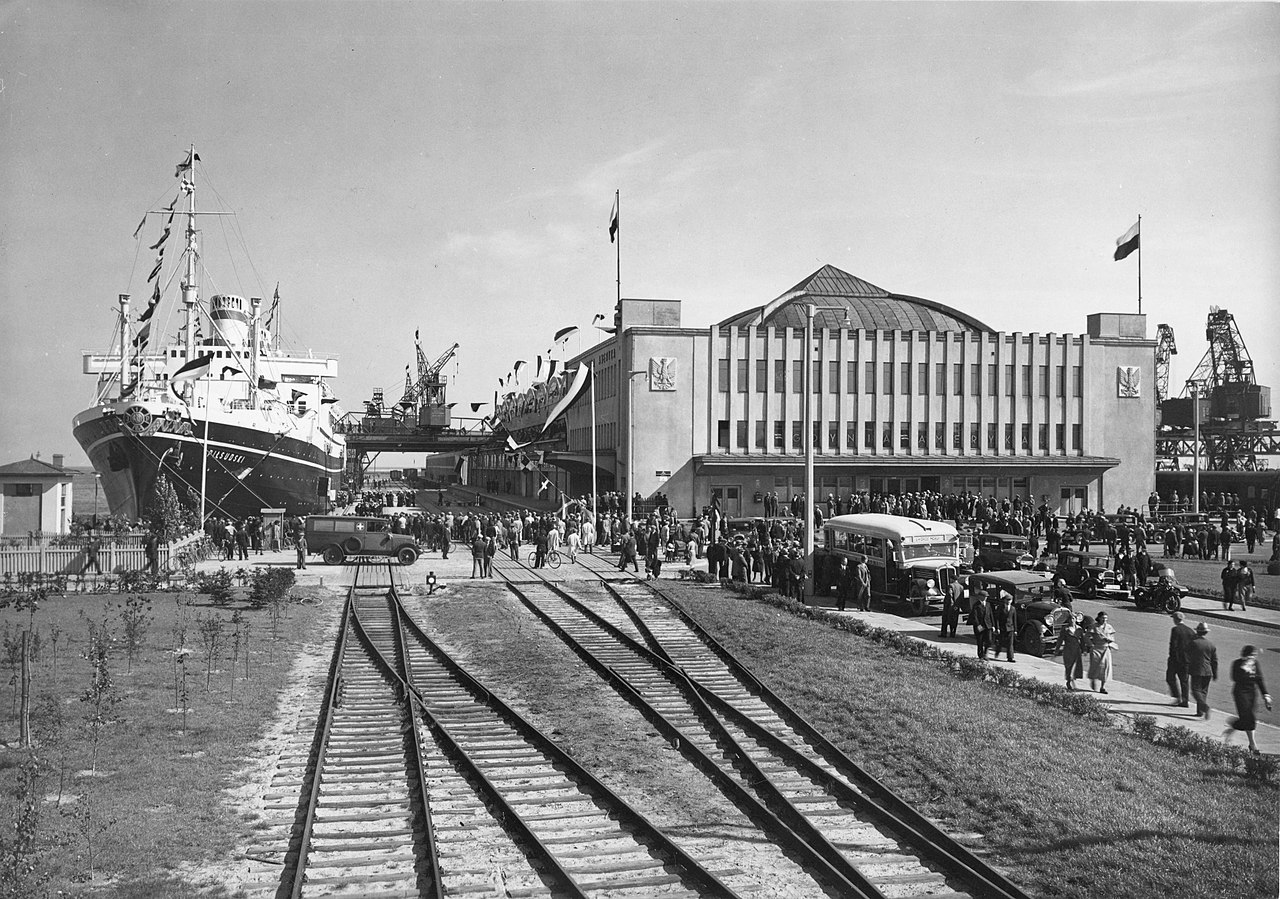When the First World War ended, the independent Polish state was born. However, although the state was formally established, its borders were still far from being determined. This was not an easy process, as there were various political, ethnic, historical and economic arguments that needed to be taken into consideration. At certain points, some of them were contradictory, however, at other times it seemed likely that an agreement could be reached. The delineation of some of the borders – primarily in the East – was forged in armed struggle. Other borders – mainly those with Germany – were agreed during the Paris Peace Conference, which began in January 1919, and culminated in the peace treaty with Germany.
by Andrzej Zawistowski
The need for the sea
Among Poland’s demands, the question of granting Poland access to the sea was the most important. There was nothing bizarre in this request. Only free access to seaports would give the re-established country a chance to access free international trade. The Baltic Sea has been Poland’s window to the world for centuries. Barges full of grain have long sailed along the Vistula River to the ports in Gdańsk (German: Danzig), Elbląg and Braniewo and from there shipped to Western Europe. When Prussia took over Pomerania at the end of the 18th century, free access to external markets was restricted. Agricultural entrepreneurs from the Kingdom of Poland, which belonged to Russia, now needed to take into account the new customs border that spanned the Vistula. Duties imposed by the Prussian state eventually reached 50%, which effectively discouraged this export route. It also had a negative impact on the economy of Gdańsk itself because the port was losing its best customers. However, over time the city developed a successful shipbuilding industry, providing employment to thousands of newcomers. Before the outbreak of the First World War, there were already 122 industrial plants in Gdańsk and 190,000 city residents. Thanks to the emergence of the railway, the port was also revived. In the last, pre-war year of 1913, Gdańsk served almost 3 thousand ships, reloading 2,112 thousand tons of cargo. However, this was not such a grand achievement after all – even in landlocked Szczecin, greater numbers of goods were being reloaded.

As the Great War drew to a close, it became time to make some decisions. A Polish state with free access to the sea was already mentioned by the American President Woodrow Wilson in his fourteen-point peace-program, which was announced in January 1918. It is not surprising therefore, that among the Polish postulates submitted to the Paris Peace Conference, demands for Pomerania, along with Gdańsk and its port, were included. This request was supported by both historical (the centuries-old affiliation of the city with the Republic of Poland) and economic arguments. Unfortunately, this request could not be implemented for ethnic reasons. The vast majority of Gdańsk’s residents – approx. 90 % – considered themselves to be Germans, unlike the inhabitants of other areas in surrounding Pomerania. In this situation, the victorious powers debating in Paris decided to issue a judgment of Solomon. Poland received a fragment of Pomerania, although without the city itself or its port. At the same time, it was decided to create the Free City of Danzig – a self-governing administrative body under the direct authority of the League of Nations. Apart from the city itself, the area of the new free city included the immediate vicinity. This territory was marked out in such a way as to prevent Poles from digging a canal through which the Vistula could bypass the city.
Troublesome “shares” in Gdańsk
Although the Free City of Danzig was not part of the Polish state, it was incorporated into the Polish customs territory. Polish State Railways even gained free access to the local railway network. Poland’s use of the port in Gdańsk was also regulated. To manage this effort, the Port and Waterways Council was established. It was composed of five representatives from Poland and five from the Free City of Danzig. This meant that the road from Poland to the port would remain open. For Gdańsk, it was an opportunity to significantly increase port transshipments.
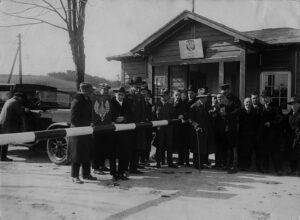
Unfortunately, the Germans constantly sought to make it difficult for Poles to use the Gdańsk port in any and every way. Already in the summer of 1920, before the formal establishment of the Free City, they blocked the reloading of weapons for the Polish army, which was then fighting the Bolsheviks. The inhabitants of Gdańsk were also in no hurry to build coal reloading facilities – one of the main Polish export goods. At this point it quickly became clear that Poland must have its own seaport. There were only small fishing ports on the [stretch of] Baltic coast granted to Poland by the great powers. Therefore, a new port had to be built from scratch, one that would serve not only trade, but also the Navy and passenger connections. Puck, Rewa and Hel, among other areas, were considered as potential locations. Ultimately, however, Gdynia was chosen – a village several kilometers north of Gdańsk, but clearly on Polish territory. When the decision was made, Gdynia was inhabited by about 1.3 thousand people – mainly fishermen and their families. In the summer, they would be joined by a few summer visitors coming to the SPA Center.
The decision to build a port in Gdynia was made as early as 1920, shortly after defeating the Bolsheviks. The priority was to create a naval port and mooring place for local fishermen. The undertaking was to be supervised by Tadeusz Wenda, an official of the Ministry of Industry and Trade, who chose the location of the new port. The following year, the first works began, and in 1923, the port was officially opened and the first ship accepted there. However, the term “port” was a bit exaggerated. Gdynia had only a wooden, short wave breaker and a half-kilometer pier. At that time, however, it was already clear that this would be a temporary solution, and the port of Gdynia would gain much more importance than planned in 1920. In September 1922, the Sejm, which was just about to end its term, passed the Act on the Construction of the Port in Gdynia. The port was to be for a common use, available to both the Navy, as well as commercial and passenger ships.
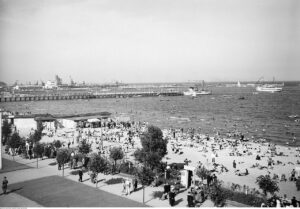
Sanation’s acceleration
A consortium consisting of Polish and French companies was involved in the port’s construction. However, it progressed very slowly. This changed only after Józef Piłsudski’s Sanacja camp assumed control. In the new government, established in June 1926, Eugeniusz Kwiatkowski was appointed the Minister of Industry and Trade and completion of the port in Gdynia became one of the new minister’s priorities. The international economic situation was not without significance – Polish coal was needed in Scandinavia and other ports of Western Europe. Poland needed to hurry and make sure that these expectations were not satisfied by another exporter. Thus new companies appeared on the construction site – from Poland, Belgium and Denmark and soon the work started with a redoubled force.
An impressive port was built. Its water area was 1,414 ha,and the depth at the quays was up to 12 meters. The total length of the quays was almost 13 km, and they were adjacent to 673 ha of port areas. They built 55 warehouses, cold stores, smokehouses, a rice mill, an oil mill, a banana ripening room and a canning factory in this area. Coal, fuel, wood and food dominated among the goods handled by ships there, and minerals, cotton and rice were brought into Gdynia. It was one of the most modern commercial ports in Europe.
The military port was located north of the commercial port – in the area of the former village of Oksywie, now a district of Gdynia. Although the construction of the port was completed in 1930, it had been the main base of the Polish Navy since 1926.
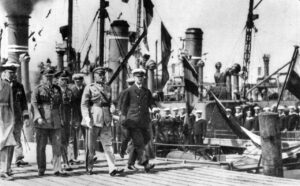
Coal, Jaffa oranges and bananas (ripening)
Gdynia also became a port for passenger traffic. In 1927, the flags of the first Polish sea passenger ships were raised. However, the real boom of this type of transport took place only in the 1930s when the Gdynia-America Linie Żeglugowe S.A. was established. It was a Polish-Danish undertaking, although gradually the balance of power in the company would eventually tilt decisively towards Polish hands. This line mainly served connections to New York and the ports of Central and South America. A separate line served the Constana-Haifa connection, used by Jewish immigrants on their way to Palestine. Eight ships sailed under the GAL colors, including the modern ocean liners “Sobieski”, “Chrobry” as well as “Batory” and “Piłsudski”. Each of these two ships could accommodate as many as 796 passengers and 350 crew. From 1933, passengers could use the modern and spacious building of the Maritime Station.
The construction of the port and its facilities attracted new investments to Gdynia. The most important of them fully exploited the port’s potential and shipyards – both civil and military – were established. In the second half of the 1920s, the construction of a coal transfer route was established, through which coal from Silesia was to be delivered to the quay of the Gdynia port. This investment was completed in 1937.
Gdynia’s success was not welcomed by neighboring Gdańsk. The Germans there looked at the Gdynia investment – first with irony, then with interest, and finally with anger. The Gdynia port decreased the profits that Gdańsk could derive from Polish exports and imports. It even happened that in 1930 the authorities of the Free City of Danzig brought a lawsuit against Poland to the International Court of Justice in The Hague. They demanded a complete cessation of the investment in Gdynia, which was supposed to “bring the port of Gdansk to ruin”. It was argued that since Poland was building its own port, there was no point in maintaining the artificial status of a Free City any longer, and Gdańsk should return to Germany. In 1931, Gdańsk terminated the agreement under which the Polish Navy could use the local port. In 1932, however, the Polish ship Wicher demonstratively entered the port of Gdańsk, thus forcing the recognition of Polish rights in the Free City. Finally, an agreement was reached. The issue of Polish warships was regulated and Gdańsk was guaranteed a share in Polish sea trade at the same level as Gdynia had. Despite the tensions, in 1938, Gdańsk passed 23.5 % exports and 7.5 % Polish imports.
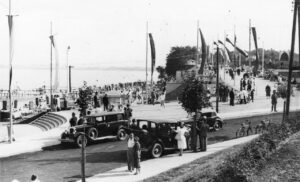
After all of this investment, new residents began to arrive in Gdynia and a modern city began to replace the small village. When Gdynia received city rights in 1926, about 12 thousand people lived there – nine times more than six years earlier. The city was built on the basis of carefully prepared plans which greatly influenced its shape. The flats were built not only by the local Housing Development Society, but also by many of the enterprises that had emerged in the city. Tax relief was an incentive for investors. Public buildings and offices were also built. In 1938, Gdynia numbered approximately 122 thousand inhabitants – over 90 times more than just 18 years earlier!
The city and the port of Gdynia are, next to the Central Industrial District, the most important symbol of the success of the Second Polish Republic. The great impact they had on the development of the Polish maritime economy is evidenced by the number of sea-going ships sailing under the Polish flag. In 1926 there were six of them, in 1938 – 71. Altogether, the successes of the Central Industrial District and Gdynia are testimony to the [persistence and drive of the deputy prime minister of Poland], Eugeniusz Kwiatkowski.
Read more: Polish interwar cities – each modern, yet different
Author: Dr hab. Andrzej Zawistowski– Professor at the Warsaw School of Economics, employee of the Pilecki Institute.
Translation: Alicja Rose & Jessica Sirotin

